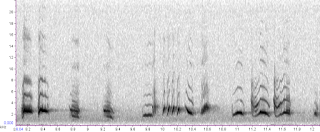Le Conte's Thrasher calls at dusk at Corn Creek. The Great Crested Flycatcher-like alarm call is typical. The calls at the end, which I believe were made by the same bird, are similar to ratchet-like calls of other mimids.


A Crissal's Thrasher was in full song in the top of a tree one morning at Corn Creek. Both thrashers sing only sporadically, and I didn't get to hear the Le Conte's song, which is very similar.



Phainopepla calls were omnipresent at Corn Creek.

This raspy call was by a male Phainopepla interacting with another in flight.

Phainopepla singing

Abert's Towhee, two different alarm calls (Henderson).

Bewick's Wren, raspy scold, at Corn Creek.
.mp3.png)
.mp3.png)
Black Phoebe call (Henderson).

Black-tailed Gnatcatchers in basic plumage are similar in appearance to Blue-gray except under the tail but the calls are quite different. Two examples of the "most common territorial advertising call" (BNA), given year round by males (Henderson).


scolding call, usually given singly

Cassin's Kingbirds winter sparsely in the region (Henderson).


The Costa's Hummingbird call sounds like the tik of a Northern Cardinal (Henderson).

Gambel's Quail flock calls

calls in flight

assembly call/song (Henderson).

All the Verdins I observed were extremely vocal:
contact calls (Corn Creek).

chip alarm calls (Henderson).

song.

A recording of a pair of Verdins mating.
The Audubon's Yellow-rumped Warbler chip is significantly different to that of Myrtle's, a twik versus a chup (Henderson).

Western Bluebird flight calls are monosyllabic compared to the bisyllabic calls of Eastern Bluebirds (Corn Creek).

contact calls between birds perched in a bush (with Cedar Waxwings).
.mp3.png)
.mp3.png)
Long-eared Owls hooting and mewing shortly after sunset from a roost in a mesquite thicket. Calling only lasted a few minutes.
Two birds (presumed males) hooting (6.00pm, Feb, NV)
.mp3.png)
Hooting and mew-like (alarm?) calls
.mp3.png)
.mp3.png)
No comments:
Post a Comment